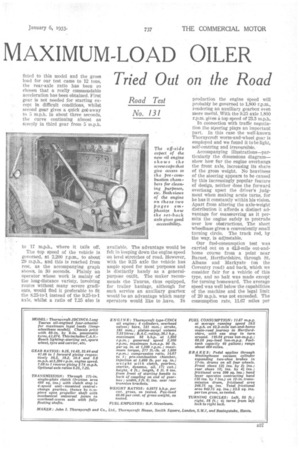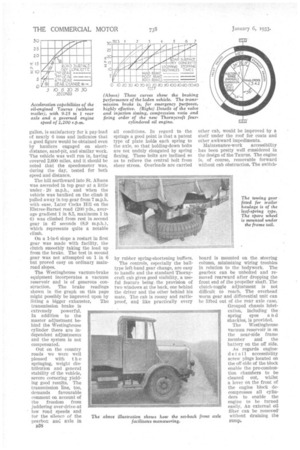A NEW
Page 50

Page 51

Page 52

If you've noticed an error in this article please click here to report it so we can fix it.
MAXIMUM-LOAD OILER
Tried Out on the Road
AN early opportunity has been taken to subject to our standdard form of road test with full legal load the new Thornycroft Taurus maximum-load oil-engined four-wheeler. The power unit fitted is the CINC4 type (with pre-combustion chamber) recently produced by the company after a prolonged experimental period, and it was fully described in our issue dated October 28, so that in this article we shall refer only to features of it which made themselves noticeable in a test of its road performance.
At 1,800 r.p.m. the four-cylindered engine develops 92 b.h.p.; as tested it was governed to 2,200 r.p.m., its capacity being no less than 7i litres. A six-cylindered unit of the same type gives 147 b.h.p. at 1,800 r.p.m.
The four-cylindered engine and four-speed gearbox are mounted as a unit, weighing 17i cwt., and especial care has been taken to damp out vibration by employing cushion mountings fore and aft. The front boss of the crankcase rests upon a platform supported on two groups of six coil springs in compression-Ine at each side of the boss. Upward
movement is limited by a springloaded cap. Two trunnions at the rear complete the three-point suspension and they are mounted in stout rubber bushes. In practice the engine-gearbox mounting gives a creditable measure of insulation, not forgetting that the big engine has
but four cylinders ; bad vibration is noticed immediately upon boarding a vehicle but becomes much more irksome after a full day's work on the road, so that it would not have escaped us. The engine runs well at low speeds. Its weight without clutch, gearbox, starter, radiator, water and oil is 13i cwt.
As regards the starting and electrical equipment of the vehicle, the C.A.V.-Bosch 24-volt axial starter is operated by two 105-amp. 12-volt batteries supplied by a 5i-in. 260watt dynamo. It started the engine when cold instantaneously.
A little grey smoke was emitted for a minute or two but it was noticed that when starting as well as on the road (after gear changing, idling, etc.) the volume, density and odour were low.
The vehicle was driven straight away and London was traversed before starting the fuel-consumption test. During the 10 miles of traffic negotiation the characteristic of the vehicle which made itself most apparent was that of acceleration. Although no auxiliary gearbox is to 17 m.p.h., where it tails off.
The top speed of the vehicle is governed, at 2,200 r.p.m., to about 29 m.p.h., and this is reached from rest, as the accompanying graph shows, in 30 seconds. Plainly an operator whose work is mainly of the long-distance variety, involving routes without many severe gradients, would find it preferable to fit the 8.25-to-1 instead of the 9.25-to-1 axle, whilst a ratio of 7.25 also is
available. The advantage would be felt in keeping down the engine speed on level stretches of road. However, with the 9.25 axle the vehicle has ample speed for most purposes and is distinctly handy as a generalpurpose outfit. The maker recommends the Taurus, thus equipped, for trailer haulage, although for such service an auxiliary gearbox would be an advantage which many operators would like to have. In
production the engine speed will probably be governed to 1,800 r.p.m., rendering an auxiliary gearbox even more useful. With the 9.25 axle 1,800 r.p.m. gives a top speed of 23.3 m.p.h.
In connection with traffic negotiation the steering plays an important part. In this ease the well-known Thornycroft worm-and-vvheel gear is employed and we found it to be light, self-centring and irreversible.
Accompanying illustrations—particularly the dimensions diagram— show how far the engine overhangs the front axle, increasing its share of the gross weight. No heaviness of the steering appears to be caused by this increasingly popular feature of design, neither does the forward overhang upset the driver's judgment when making acute turns, for he has it constantly within his vision. Apart from altering the axle-weight distribution it affords a distinct advantage for fnanceuvring as it permits the engine safely to protrude over low obstructions. The short wheelbase gives a conveniently small turning circle. The track rod, by the way, is adjustable.
Our fuel-consumption test was carried out on a 42.3-mile out-andhome course from a point near Barnet, Hertfordshire, through St. Albans and Markyate (on the Coventry road) and back, which we consider fair for a vehicle of this type, and no halt was made except for turning homeward. The average speed was well below the capabilities of the machine and the legal limit of 20 m.p.h. was not exceeded. The consumption rate, 11.67 miles per
gallon, is satisfactory for a pay-load of nearly 6 tons and indicates that a good figure would be obtained even by hauliers engaged on shortdistance, sand-pit, and similar work. The vehicle was well run in, having covered 2,600 miles, and it should be noted that the speedometer was, during the day, tested for both speed and distance.
The hill northward into St. Albans was ascended in top gear at a little under 20 m.p.h., and when the vehicle was baulked on the climb it pulled away in top gear from 7 m.p.h. with ease. Later Cocks Hill on the Elstree-Barnet road (200 yds., average gradient 1 in 8Z, maximum 1 in 6) was climbed from rest in second gear in 47 seconds (8.9 m.p.h.), which represents quite a notable climb.
On a 1-in-6 slope a restart in first gear was made with facility, the clutch smoothly taking the load up from the brake. The test in second gear was not attempted on 1 in 6 but proved easy on ordinary mainroad slopes.
The Westinghouse vacuum-brake equipment incorporates a vacuum reservoir and is of generous construction. The brake readings shown in the graph on this page might possibly be improved upon by fitting a bigger exhauster. The transmission brake is extremely powerful. In addition to the master adjustment behind the Westinghouse cylinder there are independent adjustments and the system is not compensated.
Out on the country roads we were well
pleased with t h e springing, weight dis!tribution and general stability of the vehicle, severe cornering yielding good results. The transmission line, too, demands favourable comment on account of the freedom from juddering over-drive-at low road speeds and for the silence of the eearbox and axle in
B38 all conditions. In regard to the springs a good point is that a patent type of plate holds each spring to the axle, so that holding-down bolts are not unduly elongated by spring flexing. These bolts are inclined so as to relieve the central bolt from sheer stress. Overloads are carried by rubber spring-shortening buffers.
The controls, especially the balltype left-hand gear change, are easy to handle and the standard Thornycroft cab gives good visibility, a useful feature being the provision of two windows at the back, one behind the driver and the other behind his mate. The cab is roomy and rattleproof, and like practically every other cab, would be improved by a shelf under the roof for coats and other awkward impedimenta.
Maintenance-work accessibility has been pretty well considered in the design of the Taurus. The engine is, of course, removable forward without cab obstruction. The switch board is mounted on the steering column, minimizing wiring troubles in relation to the bodywork. The gearbox can 'be unbolted and removed rearward after dropping the front end of the propeller shaft. The clutch-toggle adjustment is not difficult to reach. The overhead worm gear and differential unit can be lifted out of the rear axle case.
Grouped chassis lubrication, including the spring eyes a n d shackles, is provided.
The Westinghouse vacuum reservoir is on the near-side frame member and the battery on the off side.
As regards enginedetail accessibility screw plugs located on the off-side of the block enable the pre-combustion chambers to be cleaned out, whilst a lever on the front of the engine block decompresses all cylinders to enable the engine to be turned easily. An external oil filter can be removed' without draining the sump.




























































































